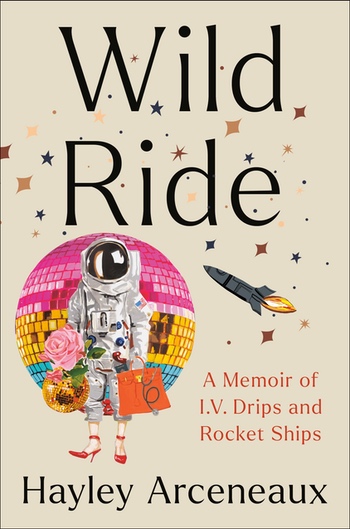Review: Wild Rideby Jeff Foust
|
| “We were never given a full rundown of what to expect with training,” she writes. “SpaceX had never had a civilian astronaut crew, so they were building the training as were going through it and adding additional training here or there as needed.” |
But what stands out among the flights by the wealthy and by governments is Inspiration4. That private mission in September 2021 flew four people on a Crew Dragon in Earth orbit for three days, a mission that served as a proof-of-concept that relatively ordinary people could go to space and back, safely and successfully, with just several months of training. While the mission was funded and commanded by a billionaire, Jared Isaacman, two of the three others were winners of contests, one a competition and the other a raffle.
The third was Hayley Arceneaux, a physician assistant—and former patient—at St. Jude Children’s Research Hospital, which would be the beneficiary of fundraising linked to the mission. In Wild Ride, she tells the story of both her childhood battle with cancer and her unexpected flight to space.
The first half of the book is focused on her cancer diagnosis and treatment. In just one week at the age of ten, she went from having a lump above her knee to going to St. Jude to begin cancer treatment. What followed was years of chemo and surgeries that eventually cured that cancer. It also left her, she explained, with a sense of adventure—she traveled the world in college and afterwards—as well as gratitude towards St. Jude that she sought to repay by working there, finally being hired as a physician assistant in 2020.
She had been there for less than a year when she got a request from the hospital for a meeting about a “unique opportunity,” which turned out to be the offer to fly on Inspiration4. Her response, she recalls, came quickly: she needed to talk to her family, “but my answer is yes.”
Soon she met with Isaacman and others involved with the mission, and was off to SpaceX for briefings and suit fittings. After the other two members of the crew were selected, they were off for a whirlwind training regime. “We were never given a full rundown of what to expect with training,” she writes. “SpaceX had never had a civilian astronaut crew, so they were building the training as were going through it and adding additional training here or there as needed.”
She goes through that training, and the flight itself, in the second half of the book. Much of that was recorded for a Netflix documentary around the time of the mission (see “Review: Countdown: Inspiration4 Mission to Space”, The Space Review, October 4, 2021); Arceneaux recalls that, the first time she met with Isaacman in person, there was a film crew in tow.
There are, though, some additional insights from the book. Some are humorous: She describes taste-testing food that was being considered for the mission, including “food cubes” developed by SpaceX intended for contingencies like an extended stay in orbit, a combination of salmon, avocado, and kale. “The texture was gelatinous but somehow also chalky. And the taste was… as you would imagine shelf-stable salmon mixed with kale would taste.” Fortunately, the food cubes weren’t needed for the mission.
| “The texture was gelatinous but somehow also chalky. And the taste was… as you would imagine shelf-stable salmon mixed with kale would taste.” |
She also notes that two members of the crew—she didn’t say who—felt nausea after reaching orbit requiring her to give them shots of antinausea medication that cleared up the problem. She adds that, near the end of the mission, “the physiological effects of zero gravity had caught up with me and I wasn’t feeling hungry.” Those are more honest reflections of the challenges of living and working in space than the Netflix documentary offered.
Arceneaux is back at St. Jude, but also working part-time for SpaceX helping medically train commercial astronauts. “I haven’t transformed into a different person, though” she concludes of her spaceflight experience. “I’ve just become more me.” That spirit comes through in Wild Ride.
Note: we are using a new commenting system, which may require you to create a new account.
